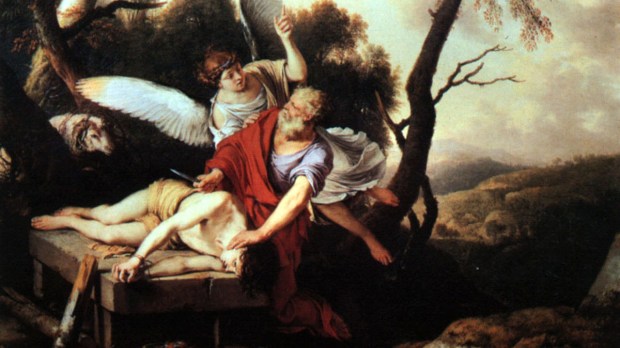Help Aleteia continue its mission by making a tax-deductible donation. In this way, Aleteia's future will be yours as well.
*Your donation is tax deductible!
Just as finding the 10 commandments clearly listed in the Bible is a difficult (if not impossible) task, locating the mountain where the binding of Isaac took place is not an easy matter either. And for pretty straightforward reasons. To begin with, the Hebrew Bible (that is, the “Old Testament”) includes two different passages mentioning Moriyya (Mount Moriah), each one of them with a different spelling. The spelling also depends on the manuscript one is reading, and on the tradition one is looking into.
Take, for example, the Samaritan Bible. This bible is a compilation of the first five books of the Hebrew Bible (the Pentateuch, the Torah) written in the Samaritan script. It dates back to one of the early, ancient versions of the Hebrew Bible, compiled during the Second Temple period (between 516 BC up until the destruction of the Temple). Since it is written in Samaritan Script, it is naturally spelled differently from the Hebrew. In this bible, the name of the mountain is spelled “’ereš ha-mmôrā’āh.” Scholars claim this name seems to derive from a root meaning “to see,” the name thus meaning “the land of vision.” The translation makes sense, considering it was there where Abraham saw the angel of God stopping his hand right before the sacrificial knife could reach Isaac.
Whereas the reference to the Samaritan Bible might seem obscure, this “land of vision” made its way all the way to the Vulgate —the main, official Latin version of the bible in the Roman Catholic Church. Through a Greek translation (that of “Symmachus the Translator,” probably a Samaritan who converted to Judaism and eventually became a rabbi according to some sources), in which Abraham is sent to “tês optasías, “the land of (visual) appearance,” of the “manifestation.” St. Jerome admired Symmachus’ work, and used it as one of his sources to compose his own Latin translation, where we read “in terram Visionis” (“into the land of Vision”).
But where is this “land of Vision” exactly?
Samaritanism is an Abrahamic, monotheistic, and ethnic religion that understands itself as that which began with Moses, unaffected and unchanged over millennia. Consequently, Samaritans believe Judaism (and thus the Jewish Torah) has been corrupted throughout the ages, no longer adhering to God’s mandates as revealed high atop Mount Sinai. It is only understandable that while Jews consider the Temple Mount in Jerusalem as the most sacred location on Earth, Samaritans think Mount Gerizim is, instead.Both traditions claim the place they consider holiest to be where the binding of Isaac took place.To make matters more complicated, Muslims believe Moriah (“Marwa,” in Arabic in the Quran) is close to the Kaaba in Mecca, Saudi Arabia. Rams’ horns were preserved in the Kaaba until 683. These were believed to be the remains of the sacrifice of Ishmael, the first son of Abraham, who most Muslims believe was who was tied down and almost sacrificed.
Let us take a look at the two biblical references to Moriah.
The first reference to Moriah is found in Genesis 22. In it, it appears to be the name given to a mountainous region. The text reads:
“Then God said, ‘Take your son, your only son, whom you love—Isaac—and go to the region of Moriyya. Sacrifice him there as a burnt offering on a mountain I will show you.”
(Cf. Gen 22, 2).
The second reference is found in the second book of Chronicles:
“Then Solomon began to build the temple of the Lord in Jerusalem on Har Moriyya (Mount Moriah), where the Lord had appeared to his father David. It was on the threshing floor of Araunah the Jebusite, the place provided by David.”
(2 Chronicles, 3).
Jews identify the region mentioned in Genesis (and the specific mountain where the near-sacrifice is said to have occurred) with the mount mentioned in the Book of Chronicles as the place where Solomon’s Temple is said to have been built. Furthermore, both these locations are also identified with the current Temple Mount in Jerusalem. Even if the spelling is different in Genesis and Chronicles, tradition has interpreted these as the same place, this being the reason why most rabbinical literature speculated that the name “Moriah” was a linguistically corrupted reference to the Temple, suggesting translations like “the teaching-place,” “the place of fear,” or even “the place of myrrh.”
Some modern biblical scholars think the name is a reference to the Amorite instead. The word would have lost its initial “a” (a phenomenon quite common in most ancient literature). According to these scholars, the name should be interpreted as meaning “the land of the Amorites,” a certain highland inhabited by Canaanite mountaineers. The Septuagint indeed refers to the location as “Amoria” in 2 Chronicles 3, 1. However, some other scholars also identify the place with Moreh, where Abraham built an altar, according to Genesis 12, 6. This would eventually support the Samaritan belief that the near-sacrifice of Isaac occurred on Mount Gerizim: the altar mentioned in Genesis 12 is said to had been located in a hill near Shechem, which happens to be near Mount Gerizim.

